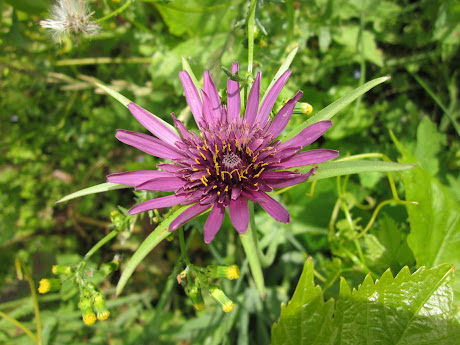To Fedge or not to Fedge...
... that is the question I'm pondering this rainy Easter weekend.
I've spent over 17 years fighting the ivy that comes over the fence from the public land next door. It's hard work - and a losing battle - to keep it under control, perhaps it's time to rethink things a little?
I'm tempted to treat the fence ivy like a hedge (aka a fedge*) and control it with shears, rather than removing it completely. That'll reduce the effort required on that part of the garden, so I can focus on keeping it at bay from the borders.
The ivy looks more attractive than the wooden fence, protects it from the weather, and also forms a good food source for wildlife. The bees love the flowers in autumn and it's been a joy to watch chattering flocks of long tailed tits flutter through and pick off the berries over the winter.
Sometimes it's better to go with the flow and work with what nature gives you, rather than stamp your own ideas all over the garden.
Fingers crossed it works.
* = most fedge information available online concerns the use of living willow. However, the urban dictionary defines a fedge as 'a fence that has become completely overwhelmed by foliage so it now looks like a hedge'. That'll do me.











We went with the flow in a similar situation and clip the ivy every year to keep it 'tidy'.
ReplyDeleteIt provides a glossy green backdrop. The wildlife love the flowers (it is literally buzzing when the flowers are out), the berries and birds nest in it. I think the toots originate from the other side of the fence and dread someone chopping them. There's a photo on my 15 March post.
It's making more and more sense Sue, especially as I have a long expanse of fence with no border in which to put climbers as an alternative. There's no chance of anyone cutting off the roots on the other side as it's public land - that's why anything I remove gets swiftly replaced by a fresh onslaught from t'other side.
ReplyDeleteSounds like a plan to me. Also, if you try to remove it, you will probably remove a good portion of the fence as well. An old neighbour removed the ivy and then realised it was holding the fence together!
ReplyDeleteI don't think it's quite at that stage yet, hence the need for hedge trimmers to keep it that way ;)
DeleteI think that's what I would do too. Flighty xx
ReplyDeleteHurrah :) xxx
DeleteDefinitely fledge, and hope a wren moves in. It'amazing how much light is reflected back too, so win, win.
ReplyDeleteActually there was a wren posing on there the other day, perhaps there's a nest there already. They usually nest in the Clematis balearica on the opposite side of the garden - they're really loud for such a small bird!
Deleteour fedge is a concrete slab wall - mostly covered by ivy from next door.
ReplyDeleteWe get a sudden swathe of brown leaves as they hack a bit out.
Not a fan of ivy (was startled by the idea of flowers and berries as ivy in South Africa is strictly leaves!) but it is peaceful green 'borrowed scenery'.
I need to trim the octopus arms every few weeks.
Can only DREAM of 'clipping once a year'.
I wasn't a fan for ages - I used to think it was rather funereal. But watching it in the landscape surrounding our garden, I've come to appreciate it.
DeleteYep, we've got fedge and the back and it works a treat. Well, I think so anyway.
ReplyDeleteThat's you and Sue who've got one already then - sold to the blogger in Chippenham :)
DeleteFedge, fedge, fedge, fedge... And if you don't clip back too hard you'll get birds nesting as well as feeding. Though we have a collapsing fence thanks to not cutting back enough...
ReplyDeleteIvy clearly provokes lots of comments!
That is my concern, especially as it invades from the public land so I can imagine it building up from there and pushing the fence over...
Delete